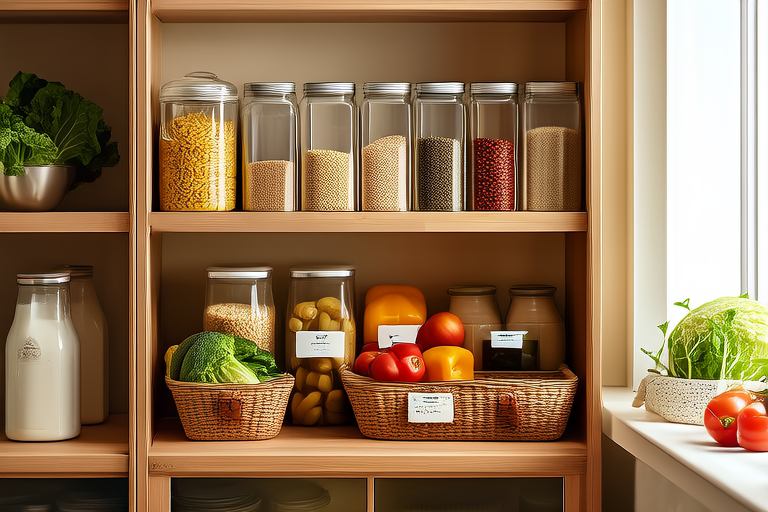Introduction: The Importance of Proper Food Storage
Proper food storage is not just about saving money; it’s also about ensuring the safety and quality of the food you consume. By storing your groceries correctly, you can extend their shelf life, reduce waste, and maintain optimal flavor and nutrition. Whether you’re a seasoned cook or a beginner in the kitchen, understanding how to store different types of groceries is crucial for a well-functioning pantry. This guide will walk you through the best practices for storing various foods, from fruits and vegetables to dairy and grains.
Understanding Temperature Zones in Your Home
One of the most important aspects of proper food storage is knowing where to store each type of food based on its temperature requirements. Most homes have three primary zones for storing food: the refrigerator, the freezer, and the pantry.
Refrigerator Storage
The refrigerator is ideal for perishable items that need to be kept cool but not frozen. Temperature is key here—ideally, your fridge should be set between 32°F and 40°F (0°C to 4°C). This range slows down bacterial growth while keeping food fresh.
- Milk, eggs, and dairy products: These should always be stored in the coldest part of the fridge, typically the back.
- Meat and poultry: Store raw meat on the bottom shelf to prevent juices from dripping onto other foods. Cooked meats can go on higher shelves.
- Vegetables and fruits: Many fruits and vegetables emit ethylene gas, which can cause other produce to ripen faster. Use crisper drawers to separate these from more delicate items.
Freezer Storage
Freezing is an excellent way to preserve food for longer periods. Make sure your freezer is set to 0°F (-18°C) or lower to ensure everything stays frozen solid.
- Bread: Freeze bread to keep it fresh for up to three months.
- Soups and stews: Portion out soups into freezer-safe containers for easy reheating later.
- Leftovers: Freeze leftovers within two days of cooking to avoid spoilage.
Pantry Storage
The pantry is best suited for non-perishable items that don’t require refrigeration. Keep your pantry dry, cool, and dark to prevent moisture and pests.
- Canned goods: Store cans upright on sturdy shelves.
- Grains and cereals: Use airtight containers to protect against moisture and insects.
- Pasta and rice: These can last several months if stored properly.
Maximizing Shelf Life with Proper Packaging and Containers
Using the right packaging and containers can significantly extend the shelf life of your groceries. Here are some tips for different types of food:
Fruits and Vegetables
Fruits and vegetables are highly perishable and require careful handling.
- Berries: Rinse them gently before placing them in a single layer on paper towels, then transfer to an airtight container lined with another paper towel.
- Leafy greens: Wash and spin dry, then wrap in paper towels and place in a sealed plastic bag.
- Root vegetables: Potatoes, onions, and garlic should be stored in a cool, dry place away from light.
Dairy Products
Dairy products like milk, cheese, and yogurt benefit from proper storage to maintain freshness.
- Cheese: Wrap cheese in parchment paper or wax paper, then place it in a resealable plastic bag.
- Yogurt: Keep yogurt in its original container, but make sure it’s tightly sealed after each use.
Baked Goods and Snacks
Baked goods and snacks can become stale quickly if not stored properly.
- Bread: Store bread in a bread box or a paper bag at room temperature.
- Cookies and crackers: Place in an airtight container to keep them crisp.
Practical Tips for Staying Organized and Reducing Waste
Staying organized is key to reducing food waste and making the most of your grocery budget. Here are some practical tips to help you stay organized:
First-In, First-Out Method
Use the first-in, first-out method to ensure older items are used before newer ones. Label containers with dates so you know when items were purchased.
Regular Inventory Checks
Regularly check your pantry and fridge for expired or nearly expired items. Rotate stock by moving older items to the front and placing new items at the back.
Smart Shopping Habits
Plan your meals ahead of time to avoid buying more than you need. Stick to your shopping list and avoid impulse buys.
Case Studies: Real-Life Examples of Proper Food Storage
Let’s look at a few real-life examples to illustrate the importance of proper food storage.
Example 1: The Case of the Rotting Tomatoes
Imagine you bought a bunch of tomatoes that you didn’t use immediately. If they were left on the counter, they would likely rot within a week. However, if you had placed them in the crisper drawer of your fridge, they could last up to two weeks longer.
Example 2: The Case of the Forgotten Bread
Bread can go stale quickly if left out. By freezing extra slices or the entire loaf, you can extend its shelf life by several months. When you’re ready to use it, simply thaw it at room temperature or toast it directly from the freezer.
Conclusion: Putting It All Together
In conclusion, proper food storage is essential for maintaining the quality and safety of your groceries. By understanding the temperature zones in your home, using the right packaging, and staying organized, you can extend the shelf life of your food and reduce waste. Remember to follow the first-in, first-out method, conduct regular inventory checks, and plan your meals ahead of time.
Actionable Steps:
- Set your refrigerator and freezer to the correct temperatures.
- Invest in airtight containers and proper packaging materials.
- Implement the first-in, first-out method and regularly check for expired items.
- Plan your meals and stick to your shopping list.
By following these tips, you’ll not only save money but also enjoy fresher, healthier meals. Happy storing!
